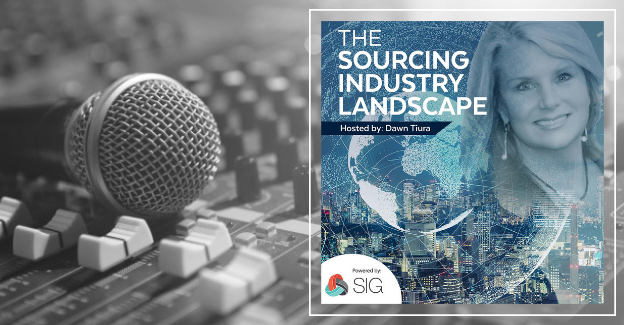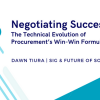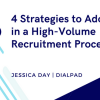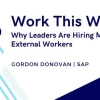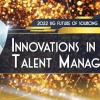In this episode of the Sourcing Industry Landscape, Dawn Tiura interviews Dan Khublall. Dan Khublall is a Senior Director – Global Head External Workforce Management Strategy and Program Director Management for Thomson Reuters. In this role, Dan directs the strategic procurement strategy for the non-employee workforce of Thomson Reuters.
Dawn Tiura: Hello everybody. This is Dawn Tiura from Sourcing Industry Group, also known as SIG. I'm excited today to introduce you to Dan Khublall. Now, Dan may not be someone you know, but it’s someone you're going to want to get to know. His view on life and business I think is pretty cool. He says, "I don't know everything, but I'll share everything I know. All views are my own." And if that's the kind of person that you want to have in your, I guess, your rolodex, on your computer, your outlook folder, your contact list—because Dan’s the kind of person—he will give you good information, and he's happy to share. Dan, I want to welcome you to today's show.
Dan Khublall: Thanks, Dawn. I'm really excited to be here and to get to participate in the SIG webinar.
Dawn Tiura: Good. So Dan is the Senior Director for external labor programs at Thomson Reuter. This is really interesting because he's got a very diverse background. And so what I'd like to do, Dan, is if you could just sort of tell us a little story about how you got started and where your passion for labor programs comes from. So let's talk about you. Where'd you get started in all this?
Dan Khublall: So I got started officially in the industry at JP Morgan in 2005. Before that, I was in sales. So, you could say I fell into staffing, which is somewhat common amongst the groups that I speak to. A lot of people say they fell into staffing, but then what we do, and influencing the future of work, working with temporary workers is intriguing to me, and it's been something I've had a passion for ever since. Funny fact is, before JP Morgan, my actual job was selling paper. So if you've ever watched The Office, I was the sales guy, Jim. And I literally sold paper, printing, and four over four colors, and you name it; we did it.
Dan Khublall: And actually, the step from the printing sales to the contingent labor program at JP Morgan was—I started working in Excel, managing spreadsheets, managing sales teams, looking at data and driving inferences from that data. And that was easily translatable to contingent labor. So, we have a lot of data in our programs and having an Excel background and having that inquisitive mind has helped me a lot.
Dawn Tiura: That is so neat. So you were selling paper, and now you're managing people. So that's a big leap.
Dan Khublall: Yeah, the leap from selling paper to people, I think it's still something that I personally battle with. So if you think about it, a lot of times we treat contingent labor like commodity, and paper is certainly a commodity. And I think it's what fuels me in focusing on what I focus on today, which is more about the candidate experience, less on the process around the candidates, more on the value of a supplier, less on the metrics around a specific supplier. So moving away from that commodity mindset to a people-first mindset is something I still have as a goal 14, 15 years later.
Dawn Tiura: Now that is an amazing thing to mention. Because you're right, everyone treats contingent labor like a commodity, and yet we're talking about people and people's lives that you're affecting. So I think that's really neat story to tell, how you got it. It's not just a commodity.
Dawn Tiura: So you have been quoted as saying, "Temporary workforce management should be on the forefront for organizations as we move to the mobile workforce, the gig economy." As well for, "Knowing how someone fits in the larger project is driving the fuel for people to seek temporary work instead of full-time employment." Tell me about that. Do you really think more and more people are going to want temporary employment?
Dan Khublall: I think it's less around the word temporary, and more of the nature of what temporary work really represents. So, to me temporary workforce represents people coming into an assignment or a project, to complete a task, and it can be extremely satisfying to complete something. And I think a lot of people in a full-time job, we have titles and we have roles, but we're sometimes looking for things to complete or looking for things to really own and drive to a finish.
Dan Khublall: Well, the world of temporary labor, or contingent labor, or whatever you want to call it, there's start and end dates. And yes, we extend workers, but there's more of a drive to completing a task or something to have an outcome that can be measured, which I think for me is very attractive. And I think a lot more of the future workforce also thinks that way because we want to do as much as we can. We're so technology enabled, why not have a gig job and also do something that you're passionate about? Like, I don't know, painting on the side. We don't want to be in the walls of an office for four days, five days a week, and I think we're seeing that change.
Dawn Tiura: That's really neat.
Dan Khublall: Evolution.
Dawn Tiura: Yeah, it's an evolution. And it's going to be interesting to see if it stays that way, or if the pendulum will swing back after another generation goes through. And I also noticed that you have additional geographies now of APAC and LATAM with Thomson Reuters. Is it different when you move across geographies, or are you getting the same feeling, that the new gig economy is actually taking hold everywhere?
Dan Khublall: Every geography has its own culture and fit. So again, what I'm saying on this on his podcast is more of my opinion, not necessarily our specific strategy. I do think that the APAC countries are more tech forward. So looking at the way banking has changed over there, people send money using their phones as a norm, and I think people applying for jobs using their phone would be more of a norm, and I think people looking for task-driven jobs would be...I'm guessing and I'm just making an inference based on what I've seen personally, would be more accepted there. I see that being more and more prevalent when I travel to places.
Dawn Tiura: Are you saying the same for APAC and LATAM? They're similar, or would you say LATAM is a different culture than APAC?
Dan Khublall: I think that LATAM is certainly a different region, and I'm not an expert in LATAM at all. Part of the reason I worked with SIG is because of the LATAM Alliance. I've gotten some information from that group. So I certainly welcome people's opinions on that topic. But I would guess it's similar. I'm just not sure. I'm not sure, Dawn.
Dawn Tiura: Okay. So tell me your passion though for sourcing. You said it's still just as strong 15 years later. Do you see yourself in workforce strategy for the rest of your life, or is there something you'd like it to evolve into?
Dan Khublall: I think that the contingent labor programs and the way we manage contingent labor programs are moving more toward a talent acquisition approach. And that's my opinion. That's what I'm pushing forward. So if that continues, if that trajectory continues, I certainly am happy to stay in this industry and do that. Moving more of the focus, less on process, more on the contingent, more on the talent side, more of a talent acquisition mindset would be certainly something I would welcome to stay part of.
Dawn Tiura: So Dan, you talk about evolving into talent acquisition. But a lot of people don't really understand what that term is. Isn't that the same as just having a contingent workforce contract?
Dan Khublall: So to me, it's not that I want to be part of talent acquisition per se. It's that talent acquisition takes more of a candidate first approach. So they look at the way that candidates are attracted to companies. They build talent pools. They work on keeping those candidates directly enticed with the company. And the way contingent labor, which is typically associated with procurement, works is we focused on the supply chain. We focus on the supplier lists. We focus on the supplier rationalizations, the distributions. I would like to see us as procurement professionals, as sourcing professionals, take more of a talent acquisition approach, meaning looking past just the supplier relationship, and understanding how those suppliers are representing our requirements and our brand.
Dawn Tiura: Okay. So does HR work with contingent workforce at all, or do they try and retain them? Is there a talent acquisition approach applied to contingent by HR?
Dan Khublall: Specifically, for us, it's not part of the HR strategy, and certainly contingent laborers are not employees. So we try to ensure that we don't blur those lines. I think it's more of a strategy at the company level in terms of: if we need people to do things, how do we engage those people? And there's two chains, or two streams rather. One is going to traditional full-time route, which involves talent acquisition. And the other is to look at the contingent workforce. But both of them result in people. I think it's looking at how do
we engage which groups when and how much.
Dawn Tiura: So you mentioned that technology has really changed and that's one of the things that keeps you engaged. How has technology changed with contingent workforce?
Dan Khublall: So for me, top of mind is the ability for companies like myself and companies out there to utilize our brand more effectively. It goes back to that talent acquisition approach. So today we can market contingent labor positions using the company brand, and that's pretty powerful. And there's ways to do that, that don't blur the lines of co-employment because we can still use a third-party product. We can still use a third-party supplier, but we can allow the company brand to show what we're looking for and take more of that, again, talent acquisition type of mindset to candidates, showing them exactly who we are, what we represent, and what projects and outcomes they can expect if they were to work on temporary jobs.
Dawn Tiura: So, you make it sound like there's a challenge to...that there's competition for the same people. Is that true, or is the contingent workforce really just waiting for the next gig to land?
Dan Khublall: That's a good question. I there are definitely career contingent labor, consultant type people. And I think there're full-time people that are open to flexible work. We see a lot of these debates about working from home, if it's useful or not. We see a lot of things about open office environments promoting people to collaborate with each other. I would say that there's a degree of a full-time employees that are open to, again, outcome based assignments where they get to look at many different spectrums of companies and types of work and working in different groups and being a truly rounded, dynamic individual.
Dan Khublall: And I say that because it's been my career. This is my fourth company in 14 years, and I can say that it's been hugely beneficial to me to join a company, learn, work on a project, and then make the right move when it's the right amount of time to another company. Not for simply a title or salary, but more for, what is this job going to do? What is expected of me, and how can I contribute to that goal? And then once that goal is met, either looking for the next outcome based project or moving to another company. So, I've been a full-time employee my entire career. I certainly have not been a temporary worker, but in a way I represent that middle market of, or that middle layer of full-time employee that's looking for that outcome based approach.
Dawn Tiura: Yeah, that's interesting. And you're right, four jobs in 14 years, well it seems like a lot. I guess for the new generation, that's not very many much. And in fact they'll see a lot more than that in 14 years. And I love the idea that you look for the job for the experience side of it, for what you can give and get, and complete and accomplish. So that does make the gig economy, or the gig worker, it seems like somebody who might be very open to that kind of growth and development of themselves. I think that's very interesting viewpoint.
Dan Khublall: I almost think the gig economy and the mindset of moving people from project to project could solve a lot of the career planning challenges we have within organizations. People sometimes stay in roles for far too long. They're looking for the next step. They're not really clear on where to go. If companies provided more of an outcome-based approach and then blended more temporary staff and contingent into their workforce and provided opportunities that were more outcome based, perhaps they would hire more temporary workers, which is fine, but they would eliminate having people stuck in roles for far too long. And that's just my opinion, but I think it could be...there's some value to that.
Dawn Tiura: No, that's very true, because in any organization, not everybody has a straight line to the top, and not everyone can get there at the same speed. And it is frustrating. I see people in jobs all the time that just want that next golden ring to reach out for, but it's just not there. So I do think you're absolutely right. It could be very fulfilling for some people.
Dawn Tiura: So Dan, when people are contingent, are they always the ones that have to come into the office, or do people ever...are they ever allowed to work remotely as contingent?
Dan Khublall: Yes. It depends on every job req. that we build and every job req. that goes out to the supplier community, it's specified. Does this work need to be done on or at our TR location, or can it be done remote? I think that's common across many programs. It depends on the nature of work, but we don't have a set policy.
Dawn Tiura: Oh, okay. I'd always thought that contingent workers were always going to be onsite. So it never occurred to me that they might be from at-home employees as well. That's interesting. So where do you think the future...so I've read reports, and they say that we're going to be up to 50% contingent labor by 2025. Are you believing in those numbers? Is it still trending to hit that by 2020 or 2025, or do you think it might take a little longer, or do you think we'll never get there?
Dan Khublall: Speaking personally, not for TR. I personally believe that we will absolutely see a larger mix of contingent labor individuals. Will it happen by 2025? I would say so. If you look at the technologies that are coming out today, which things like the VMS evolution of it being more candidate focused, having the requisitions be piped directly out to candidates so people can see jobs. And then even further, things like the Google Jobs cloud platform that enables jobs just to be easier to find.
Dan Khublall: So I think there's lots of tools out there for people to see all of the options that are available to them from a career standpoint. Whether it be full-time or even temporary/gig, people are going to start being more empowered to make those decisions. And I think the allure of flexibility will always be on the side of the temporary workforce.
Dawn Tiura: So you mentioned VMS. Can you explain for our listeners what is a VMS system and why is it important?
Dan Khublall: So the VMS system is your vendor management system. It's your procure-to-pay function that you use to transact all of the job orders, and then also to manage the relationships once those jobs are filled. So it's usually a supplier relationship that governs a contract labor individual, the person that does a time sheet. VMS is responsible for doing the invoicing, and then VMS triggers payment to that supplier. So it's a huge part of the contingent labor programs out there.
Dawn Tiura: And that's the tool that you said that the applicants can actually see the job requests rather than just waiting for a recruiter to say, "How's this candidate?" They can seek out some jobs?
Dan Khublall: That's exciting piece that I'm working on here. And what we've done is we've found a technology that can take our jobs from the VMS, which the VMS typically is not candidate or front office facing. It's more of a procurement/ supplier facing tool, because it's a procurement tool. What we found is by putting a technology on top of our VMS, it allows us to build a talent portal to build a talent pools so that we can show people what temporary jobs we are offering. Again, those jobs are still going through a third-party. There's still an employment relationship via a supplier. There's nobody being directly employed by TR. But it's, for the first time, allowing candidates to see all of the jobs directly on a talent pool/career site rather than having us to rely on staffing vendors to take that message market.
Dawn Tiura: I think that's great. It's definitely a way to differentiate yourself as well.
Dan Khublall: Yeah, I think it's giving candidates a true choice. Again, going back to that, the future of work may be more contingent based, 50%, that technologies like this, creating transparency in contingent labor space for the candidates is going to make this industry just more accessible to contingents and people looking to embrace the world of temporary labor.
Dawn Tiura: That's great. So where else do you see it changing? Any—any predictions? And what I'd really love to hear is if somebody is listening to you today and they're interested in the type of thing that you're talking about, is there a college degree? Is there something you recommend for training? Is there a way to get to that path forward? What is your thought?
Dan Khublall: Looking at where program can go in the next step requires your program or your strategy to be at a certain level of maturity. There's always the basics of making sure you have your VMS, which is your vendor management system, making sure that you have a good program office, whether it be through a managed service provider, an MSP, or if you do it on your own. Once you have those steps in place and you've established full transparency, I think it's going to conferences and sharing what your ideas are. That's certainly how I got started. I've gone to conferences like SIG, and I've chatted with peers, and pushed ideas out there. And via the sort of crowd sourcing type of element from going to industry events, I've come up with a strategy. So, I'm willing to help, but I don't...I'm not sure if there's any major arena for that, other than going to conferences and having conversations.
Dawn Tiura: But one thing that's different about you, since you were so focused on the people, is that you are strong in analytics. Is that necessary do you think, to run a really good VMS program?
Dan Khublall: I think having a sense of reporting and its role in a program management is absolutely essential. Again, going back to that maturity comment—knowing what data you can access and what that data means is the first step before you even try to change things and change data in your program. I think a lot of times, certainly in the beginning of my career, I made assumptions about parts of the program or I made assumptions of ideas, and when I tried to implement them, I found that they didn't work. And if I'd only taken a look at the data beforehand, I would've realized that we either didn't have something or we didn't really understand something truly to the point of being able to change it. So yes, data and analytics, Excel, those are all critical components of an effective program manager.
Dawn Tiura: That's great. So Dan, would it be possible for me to put a link to your email out our YouTube channel with this?
Dan Khublall: Absolutely. And I'm also on LinkedIn. I'm on Twitter. I post content on LinkedIn all the time, and I'm open to dialogue any time.
Dawn Tiura: Okay, good. Because I'd love for people to be able to approach you and carry on the conversation because that's such an important part to both the growth of the SIG membership but the growth of the individuals, is to be able to pick up a phone and brainstorm with somebody or, "Hey, you said this," and, "What did you mean by that?" So I'm glad you're open to sharing. I thought you would be.
Dan Khublall: Absolutely. Yeah.
Dawn Tiura: So any last parting comments to a young professional today? I love that you said, you know, you're inquisitive, you're curious—is that the trait that you would want to instill or ask, challenge somebody to instill in themselves, or is there a particular trait besides the curiosity?
Dan Khublall: I think curiosity is certainly one thing that I fall back on a lot, and just challenging the norm is definitely true. But with that, the courage to go against the norm. I certainly have had to make decisions regarding, do I upset the apple cart to see what comes out of it? And I've done that. I've been lucky to have the right leaders above me. I've been lucky to have the right data supporting those decisions. But I think be willing to take a risk. I think if you watch anything around Jeff Bezos about innovation that's...one of my favorite taglines is ‘innovation is not doing the same thing over and over again’. Innovation is taking a risk, be willing to fail. If you're doing the same thing and you know you're never going to fail, you're not doing something new; you're just replicating.
Dawn Tiura: That is a really, really great parting comment. So I'm going to wrap you up with curiosity with the courage to move forward and risk of failure in order to innovate. I think is just a brilliant way to wrap up our conversation today. So thank you so much for joining me.
Dan Khublall: I really appreciate being part of this. I think they're a great way to give at outlook, and I appreciate the time, Dawn. So yeah, really excited to have done this. Thank you so much.
Dawn Tiura: No, thank you. I've enjoyed the few times I've got to speak with you, and I certainly see you as a rising star in our world, so I love having your perspective. And folks,
Dan Khublall, he's with Thomson Reuters out of New York City area. Please make sure that you add them into your LinkedIn, make him part of your conversation, and share this podcast far and wide. So Dan, thank you so much and have a wonderful day.
Dan Khublall: Thanks, Dawn. Same to you.
Dawn Tiura: Thanks, bye-bye.


